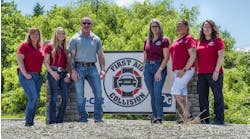DETROIT — It started out as a simple flat tire. But after trying to program the tire pressure monitoring system, this otherwise marginal repair effort set off a series of electronic roadblocks until the Nissan finally had to be hauled off to the dealership on a flatbed truck. Is this a training issue or a genuine lack of repair information access? These were some of the questions asked at the recent general meeting of the National Automotive Service Task Force (NASTF), held April 15 in Detroit in conjunction with the Society of Automotive Engineers (SAE) 2008 World Congress. As vehicles evolve with more complex systems, it’s important that independent repairers have access to the critical OEM repair data needed for something as innocuous as a flat tire, and NASTF is seeking to get the word out that it is a valuable resource and a conduit for providing the information. Much of the problem, board members assert, lies in a lack of training for technicians. “For the most part, OEMs are responding in a timely manner,” NASTF Chair Charlie Gorman says. He adds that accessing vehicle security information while maintaining the integrity of that same information is a delicate balance. There is still a long way to go until OEMs achieve full compliance with sharing necessary repair information, but NASTF has put a number of safeguards in place and launched various initiatives to achieve this end. One of these is the Secure Data Release Model (SDRM), a data exchange system launched this year that coordinates automakers, independent repairers, law enforcement, locksmith associations and others to obtain security sensitive information, key codes, PIN numbers and immobilizer resets, among other information. The SDRM can be accessed through a subscription fee — $50 for the background check and $100 per year. At the meeting, a panel of OEMs and locksmiths discussed the SDRM, still in its infancy. The locksmiths in attendance alluded to software and other “back door” means sometimes used to access the same information, but stressed that the SDRM should be endorsed as a legitimate avenue. Some shop owners are concerned that this model serves more to benefit the locksmith rather than the independent repairer, who is likely only looking for a one-time usage as opposed to a yearly subscription to vehicle security and immobilizer information. Panelist John Brueggeman, president of the California Locksmiths Association, admits there are many regulatory issues and much paperwork involved in making this arrangement successful. He adds that even if it means more hoops for the locksmiths to jump through, “I have appreciated the willingness of the manufacturers to come to the table.” “If we can get single use access that competes with those guys, it will help,” says Hensley, from Lock-Man Locksmith, in Pinellas Park, Fla. Not all OEMs are in VW’s choice not to participate in the SDRM will be “their cross to bear,” says NASTF member Dave Lanspeary, who also owns Dave’s Auto Repair in Youngtown, Ariz. He also doesn’t know whether VW will get away with this stance because of California legislation mandating OEM information access. Panelist Kurt Immekus, from VW/Audi, says the automaker maintains its security by performing a tele-diagnosis on the scan tool, which overrides the diagnostic tool, as the screen goes black from the technician’s end. “We take control of their machine, and their machine is blacked out while we use the tool.” Aaron Lowe, vice president of government affairs for the Automotive Aftermarket Industry Association (AAIA), says of the SDRM, “I think there’s still a lot of unanswered questions from the point of view of the independent shop owner.” For example, how many OEMS are participating, and will technicians have access to the same information that locksmiths have access to? AAIA is a strong proponent of legislation, and the proposed Right to Repair bill is again gaining ground in Congress this year. Board members emphasize that NASTF is neutral when it comes to taking a stance on Right to Repair legislation. Gorman says OEMs are “too far in” and have agreed to too many things to back out now. “I expect (cooperation) will continue with or without Right to Repair,” he adds. Some believe that the threat of legislation is what keeps automakers at the table and sharing information. Others think that legislation could be too binding. For example, what if a bill is written and down the road new vehicle technology is introduced that’s not covered in the previous legislation? A northern problem John Cochrane, president of Cochrane Automotive in Ontario, made the trip to Detroit and expressed this concern. “We are falling further and further behind in the vehicle repair process,” he says, adding Canada does not have a NASTF-like body to help its techs get the information they need. “It’s becoming a critical issue.” As far as Right to Repair legislation goes, Cochrane says he supports a binding bona fide resolution dispute process where all parties must appear at the table. In the meantime, usage of the NASTF Web site and the associated OEM sites continues to grow, according to the board. Online sessions over the last two years have tripled, says John Cabaniss, NASTF board member, who is also director of environment and energy for the Association of International Automobile Manufacturers (AIAM). Page views have doubled over the same period of time, he adds. Also at the Detroit meeting, Mary Hutchinson, NASTF’s administrative director, announced two new awards: the NASTF Outstanding Achievement Award and Committee Service Awards. Award winners will be lauded at the NASTF fall general meeting, which will take place during Industry Week.
|
Latest in Operations
Latest in Operations
Articles
Dumping Your DRPs
July 24, 2024
Articles
Preparing for Inspections
July 15, 2024
Articles
Playing the Long Game
July 8, 2024


